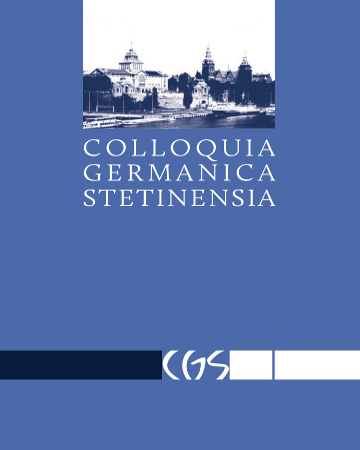







| Authors: |
Anna
Pilarski

Uniwersytet Szczeciński, Wydział Filologiczny, Instytut Filologii Germańskiej, Zakład Składni Porównawczej Języka Niemieckiego i Języka Jidysz |
| Keywords: | pro-drop configurations generative syntax Yiddish-German-Polish comparison comparative syntax |
| Data publikacji całości: | 2017 |
| Page range: | 20 (145-164) |
| Downloads ?: | 739 |
| 1. | Abraham, Werner. Satzglieder im Deutschen. Tübingen: Gunter Narr Verlag, 1982. |
| 2. | Bayer, Josef. „Was beschränkt die Extraktion? Subjekt – Objekt vs. Topic – Fokus“. In: Deutsche Syntax: Empirie und Theorie, hrsg. v. Franz Josef d’Avis, 233–257. Göteborg, Acta Universitatis Gothoburgensis: 2005. Zugriff 06.02.2017. http://ling.uni-konstanz.de/pages/home/bayer/pdf/GvteborgPaper.pdf. |
| 3. | Belletti, Adriana. „Aspects of the Low IP Area“. In: The Structure of CP and IP. The Cartography of Syntactic Structures, Vol. 2., hrsg. v. Luigi Rizzi, 16–51. New York: Oxford, 2004. |
| 4. | Chomsky, Noam. Lectures on Government and Binding. Dordrecht: The Pisa Lectures, 1981. |
| 5. | Chomsky, Noam. Some concepts and consequences of the Theory of Government and Binding. Cambridge, Mass., London: The MIT Press., 1982. |
| 6. | Chomsky, Noam. The minimalist program. Cambridge, Mass., London: The MIT Press., 1995. |
| 7. | Deprez, Viviane. „Parameters of Object Movements“. In: Studies on Scrambling: Movement and Non-Movement Approaches to Free Word Order-Phenomena, hrsg. v. Norbert Corver, Henk van Riemsdjik, 101–152. Berlin: Mouton de Gruyter, 1994. |
| 8. | Diesing, Molly. „Yiddish VP Order and the Typology of Object Movement in Germanic“. Natural Language & Linguistic Theory 15.2. (1997): 369–427. |
| 9. | Diesing, Molly. „The Upper Functional Domain in Yiddish“. In: Focus on Germanic Typology. Studia Typologica 6, hrsg. v. Werner Abraham, 195–209. Berlin: Akademie Verlag, 2005. |
| 10. | Fanselow, Gisbert. Konfigurationalität. Untersuchungen zur Universalgrammatik am Beispiel des Deutschen. Tübingen: Gunter Narr Verlag, 1987. |
| 11. | Fanselow, Gisbert. „Scrambling as NP-Movement“. In: Scrambling and Barriers, hrsg. v. Günter Grewendorf, Wolfgang Sternefeld, 113–140. Amsterdam: Benjamins, 1990, |
| 12. | Fanselow, Gisbert, Sascha Felix. Sprachtheorie 2: Rektions- und Bindungstheorie. Tübingen: Francke, 1993. |
| 13. | FORWARD = The Yiddish Daily Forward, „Wall Street and the Jew“, 15.05.2015. Zugriff 01.02.2017. http://yiddish.forward.com/articles/187090/wall-street-and-the-jews/?p=all#ixzz3XwoT9zUz |
| 14. | FORWARD = The Yiddish Daily Forward, „Non-Jewish Kids Learn Alef-Beyz“, 19.10.2013. Zugriff 19.10.2013. http://yiddish.forward.com/articles/172823/non-jewish-kids-learn-alef-beyz/ |
| 15. | FORWARD = The Yiddish Daily Forward, „Smartphones: Not Only A Danger for Hasidim“, 14.02.2014. Zugriff 14.03.2014. http://yiddish.forward.com/articles/176463/smartphones-not-only-a-danger-for-hasidim/#ixzz2ut63cJEN |
| 16. | FORWARD = The Yiddish Daily Forward, „News from Paris“, 22.11.2013. Zugriff 12.12.2016. http://yiddish.forward.com/articles/174374/news-from-paris/ |
| 17. | Grewendorf, Günther. Minimalistische Syntax. Tübingen, Basel: Francke, 2002. |
| 18. | Jacobs, Neil, Ellen Prince, Johan van der Auwera. „Jiddish“. In: The Germanic Languages, hrsg. v. Ekkehard König, Johan van der Auwera, 388–419. London, New York: Routledge, 1994. |
| 19. | Mark, Yudel. Gramatik fun der yidisher shprakh. New York: YIVO Institute for Jewish Research, 1978. |
| 20. | Mecner, Paweł. „Zu satzfinaler Subjektposition, Unakkusativität und C-Domäne im Jiddischen“. Linguistik online 80. 1/17 (2017): 71–94. |
| 21. | Mohr, Sabine. „Eine Antwort auf die Frage, wo dem Jiddischen der Kopf steht“. In: GGS (Generative Grammatik des Südens), Universität Tübingen, 2005. Zugriff 08.04.2014, http://ifla.uni-stuttgart.de/files/ggs_2005.pdf. |
| 22. | Müller, Gereon, Wolfgang Sternefeld. „Scrambling as A´-Movement“. In: Studies on Scrambling, hrsg. v. Norbert Corver, Henk van Riemsdjik, 331–385. Berlin: Mouton de Gruyter, 1994. |
| 23. | Müller, Gereon, Wolfgang Sternefeld. „Improper Movement and Unambiguous Binding“. Linguistic Inquiry 24 (1993): 461–507. |
| 24. | Pilarski, Anna. Die Operation „Merge“ im Verbalkomplex des Polnischen und des Deutschen. Frankfurt a. M. Peter Lang Verlag, 2002. |
| 25. | Pilarski, Anna. „Zur Operation Merge in den unpersönlichen się „sich“-Konstruktionen im Polnischen“. Colloquia Germanica Stetinensia 25 (2016): 299–320. |
| 26. | Rosengren, Inger. „Scrambling – was ist das?“. In: Was determiniert Wortstellungsvariation?, hrsg. v. Brigitte Haftka, 175–196. Opladen: Westdeutscher Verlag, 1994. |
| 27. | Santorini, Beatrice. „Das Jiddische als OV/VO-Sprache“. Linguistische Berichte 123 (1993): 230–245. |
| 28. | Schallert, Oliver. Wortstellungstypologie des Jiddischen im Spannungsfeld zwischen den germanischen und den slawischen Sprachen, Manuskript, Philipps–Universität Marburg, 2007. |
| 29. | Stechow, Arnim, Wolfgang Sternefeld. Bausteine syntaktischen Wissens. Ein Lehrbuch der generativen Grammatik. Opladen: Westdeutscher Verlag, 1988. |
| 30. | Vikner, Sten. Verb Movement and Expletive Subjects in the Germanic Languages. New York: Oxford University Press, 1995. |
| 31. | Wallenberg, Joel C. „Scrambling, LF, and Phrase Structure Change in Yiddish“. Lingua 133 (2013): 289–318. |